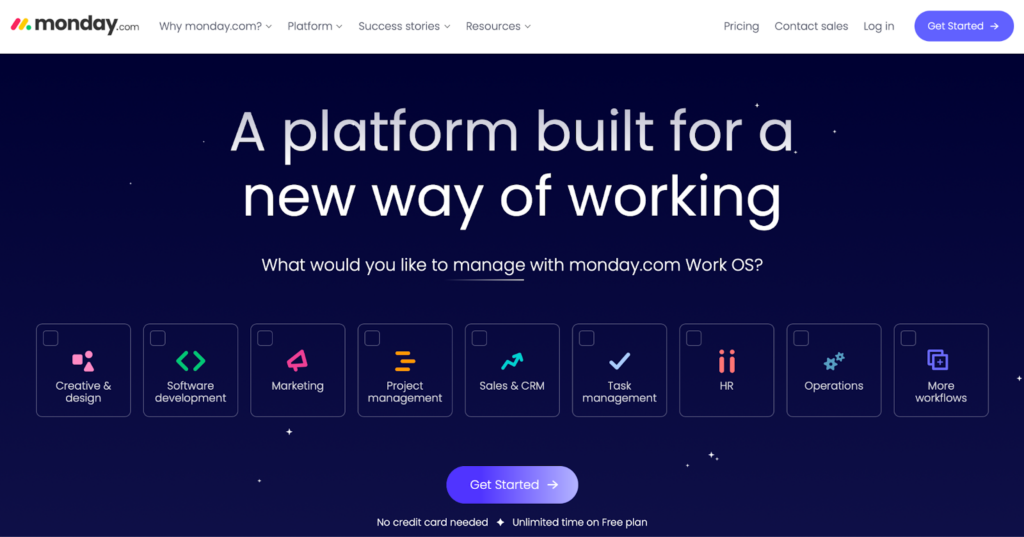“The number one biggest benefit of Codeless for Monday.com is that they are able to help us (as a hypergrowth company) scale very quickly.
They were able to become experts in every single category — from project management to construction and software development, agile or Scrum — that we asked them to write in. They met all the deadlines and delivered amazing quality every single time. They ended up creating 70 blogs in less than a month, which is unheard of.
The results have been amazing. Normally, SEO takes very long, but with a clear SEO and content strategy that Codeless also helped to shape, we really have seen results within a month. So that’s extremely, extremely rare.”
Zoe Dayan, Content Marketing Manager, Monday.com
If you’re familiar with SaaS brands, you’ve certainly heard of (and maybe use) monday.com. It’s a high-powered Work operating system that does it all, and they knew to stand out in such a competitive space, they needed to implement new strategies to grow at scale.
One of those strategies was to focus on content. They came to us in October of 2020 wanting to publish more than 70 articles (2,000 words each) in their first month of working with us… and we delivered.
In this monday.com case study, we’ll walk you through the strategy we used to help our client increase their monthly blog traffic from 12,586 to 304,856 in an 18-month period.
About monday.com
Monday.com is a work OS — an all-in-one SaaS tool that offers project management, operations processes, a sales CRM, marketing and lead management, sales enablement, design planning, and more.
They’re now used by major brands like Coca Cola, Hulu, and Universal.
Their tools are, however, designed for businesses of all sizes; there’s even a free plan that you can spend unlimited time on before deciding to upgrade.

The challenge
The B2B and SaaS niches are hyper-competitive and have been for a while. Many of these brands realize the importance of strong content from the top of the funnel all the way down to the bottom; this can make it hard to break into those SEO and content markets to rank well in search engines.
Being familiar with the industry, monday.com knew that this would be an initial challenge and that the only way to combat it would be a large amount of outstanding content at scale.
When they came to us, they laid out an ambitious task, asking for 100 articles in the first month of working together. That kind of scale can be daunting, if not impossible, for many agencies— especially while maintaining quality.
We were up for the task, however, and created a strategy to help us accomplish that goal.
The strategy
Let’s take a look at the strategy we used to create the first 100 articles for monday.com (and over 850 since!).
1. Choose a team of specialist writers
Here at Codeless, we have a strong and diverse team of writers who have experience writing about a wide range of topics. For monday.com, we’d need writers with experience writing about B2B, SaaS, project management, business management, sales enablement, and marketing.
We put together a list of writers and confirmed their availability while we worked on the content strategy.
2. Increase authority with the hub & spoke model
We knew that growing monday.com’s organic site traffic (and, as a result, their conversions) was going to be a priority of our content strategy.
In order to do that, we knew we needed to demonstrate the site’s topic authority (and increase its domain authority in the process). The best way to do that, in this case, was going to be using a hub and spoke model with pillar content and topic clusters.
In this model, the following happens:
- You create topic clusters of related keywords and topics based on keyword research
- You choose a single piece of pillar content for each cluster, which will be particularly thorough and often take the form of an “ultimate guide”
- The pillar content is the center of each cluster, allowing you to branch out and link to other articles in the cluster (and link from them back to the pillar post)

Image source: Wordable.io
There may, for example, be an “Ultimate Guide to Sales Enablement” as a pillar post, with other posts in the cluster including “Best Sales Enablement Tools” or “Sales Enablement Mistakes Not to Make.” They would all link to — and be linked from — that pillar content.
3. Define your internal standards
It’s always good to define your internal standards when working with a team of writers, but it becomes downright crucial when you’re working at scale.
It keeps everyone on the same page, and it significantly reduces the time spent sending content back to writers for revisions so more time can be spent creating great content.
For monday.com, we created a clear checklist that outlined all of our expectations for the content our writers were creating. The checklist included:
- What’s expected during the outline creation process
- What’s required in each section of the article (including word count and elements like a hook for the introduction)
- How often to include images
- What types of sources should be used
- A reminder to use statistics
- A guide on their desired brand tone
4. Create an “assembly line” approach
In order to create quality content at scale, we needed to utilize a repeatable operations system that allowed for a synchronous workflow.
This meant that writers and editors could all be working on multiple projects at once, working on content in the different stages of creating briefs, outlines, drafts, and final revisions.
With a repeatable system, we’d be able to ensure we were producing higher quality content with less time spent on management and revisions, allowing us to meet the ambitious content goal.
Editors could work on briefs, writers would then work on outlines for editors to approve, and then they’d move on to drafts and revisions. It was an assembly line approach that was fine-tuned, and scheduled to keep everything flowing smoothly.
5. Be specific in briefs for writers
We’ve already mentioned how we had a checklist that set the expectations for content production. All of our writers had easy access to this so they could reference it at any point.
We don’t just leave it at that, however. Our writers are all given detailed briefs for each individual post they’re writing. This process ensures that nothing is left open to interpretation so our writers and editors both understand exactly what each post is meant to accomplish.
The briefs we create let our writers know exactly what’s needed and when it’s due.
They’re like preliminary outlines that break down what the writer should be discussing and how, including suggestions for questions in headings, word counts for each section, and what topics to include.
Have a strong editorial team
Our editorial team is an invaluable part of the work we do. We have editors assigned to different accounts so that they’re familiar with and invested in the work that they’re doing.
For monday.com, we hired two senior editors with PMBOK certifications, giving us vertical expertise with both our writers and editors.
Our editors will create briefs for our writers, approve outlines, and then review all submitted drafts carefully. They’ll go through word-by-word to ensure that every sentence is pristine and that the topics at hand are thoroughly covered. This not only ensures a well-written post, but one that’s competitive enough to help you rank well.
The results
We started working with monday.com in the fall of 2020, and we quickly saw dramatic increases in traffic to the site overall, as well as a large number of pages ranking well.
In the 18 months we worked together, we saw monday.com’s blog traffic increase from 12,586 to more than 304,000 — an increase of 2,300% or so. In that time, we’ve created over 950 articles together that have only increased that traffic further, helping them to establish their site as a prominent figure in their space.

They’re ranking now for over 140,000 organic keywords, with 25,626 first-page rankings in the search engine results pages (SERPs).
They’ve also collected backlinks from 6,500 referring domains, going even further to increase traffic and establish the site as true topic experts.
We also have a large number of articles we’ve produced for monday.com ranking in the first position for their target keyword.

What the client had to say
The numbers speak for themselves, but the client testimonial we got from Zoe Dayan, the content marketing manager at monday.com, shared why Codeless was so valuable as an asset to their team.
Here’s what she had to say:
“The number one biggest benefit of Codeless for monday.com is that they can help us (as a hypergrowth company) scale very quickly.
They were able to become experts in every single category — from project management to construction and software development, agile or Scrum — that we asked them to write in. They met all the deadlines and delivered amazing quality every single time. They ended up creating 70 blogs in less than a month, which is unheard of.
The results have been amazing. Normally, SEO takes very long, but with a clear SEO and content strategy that Codeless also helped to shape, we really have seen results within a month. So that’s extremely, extremely rare.”
Final thoughts
While most brands don’t come to us needing 70 articles in the first month of working together, it was an exciting challenge that we were thrilled to take on.
By using specialized writers and editors, a systemized approach to content creation, and a thorough hub and spoke model featuring pillar content and topic clusters, we were able to help this client take their blog — and even their brand reputation — to the next level.
Content at scale can be invaluable… as long as it’s done right. And we can help you there.
Ready to scale up your content in quantity and quality? Learn more about how we work here.



